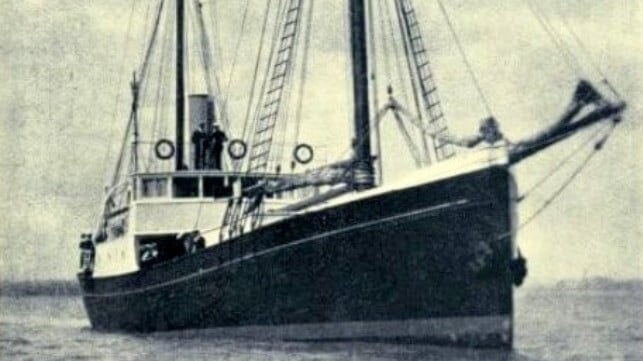Wreck of Shackleton's Last Vessel Discovered Off Newfoundland

After 102 years, the last vessel commanded by Sir Ernest Shackleton has been rediscovered on the seafloor, sitting in 400 meters of water off the coast of Newfoundland.
The Quest, a 125-tonne motor-sailing steamship built for sealing, was under Shackleton's command for a follow-on voyage to Antarctica. The project - known as the Shackleton-Rowett expedition after its financial backer, John Quiller Rowett - intended to circumnavigate the Antarctic continent and explore nearby islands, like remote Tuanaki. However, the 110-foot vessel proved to be underpowered and ill-suited for long distance polar exploration, and the expedition's progress was limited by engine difficulties and slow speed. Shortening the intinerary in order to make up for delays, Shackleton made directly for South Georgia, leaving a prestaged supply cache uncollected in Cape Town.
On Jan. 5, 1922, Shackleton suffered a heart attack and died while the vessel was at anchor at Grytviken, South Georgia - just 12 miles from the spot where Shackleton's heroic voyage of survival had ended six years before. He was just 47 years old.
The crew made a truncated attempt to continue the ship's scientific mission, then returned to England. It would be the last British Antarctic expedition for seven years.
EXPEDITION ANNOUNCEMENT. @RCGS_SGRC @CanGeo CEO @JohnGGeiger and a team of international experts is in the Labrador Sea searching for the wreck of Sir Ernest Shackleton’s #QUEST. Tx to @MemorialU @marineinstitute @WeAreShackleton @FramMuseum @ExplorersClub https://t.co/lYWko3syAy pic.twitter.com/g3DCeW6xVp
— Canadian Geographic (@CanGeo) June 10, 2024
After the end of the mission, Quest was resold and refitted many times, serving as an expedition vessel in Canada, a sealer, and - during the Second World War - as a minesweeper in Royal Canadian Navy service.
The vessel was resold again and resumed sealing in 1946, and continued in that trade for the next 16 years. Her career ended when her hull was crushed by ice on May 5, 1962, sending her to the bottom of the Labrador Sea. All crewmembers survived.
The location of the Quest's wreck remained an unsolved mystery of the Heroic Age of Exploration - until this month. The Royal Canadian Geographic Society sponsored a search for the Quest, based on historical records of the vessel's final trackline, and they dispatched the research vessel LeeWay Odyssey to carry out a sonar survey. The search was assisted by an analysis of ships' logs, weather data and other documents from the era. Well-known wreck hunter David Mearns and scholar Antoine Normandin headed up a monthslong project to piece together all available historical evidence.
On June 9, using sidescan sonar, the team found a wreck corresponding to Quest's characteristics, sitting upright and largely intact on the bottom. In a statement, Mearns said that he was certain that the wreck was the Quest, based on its dimensions and the details of its topsides.
"Finding Quest is one of the final chapters in the extraordinary story of Sir Ernest Shackleton," says expedition leader John Geiger, CEO of the Royal Canadian Geographical Society. "Shackleton was known for his courage and brilliance as a leader in times of crisis. The tragic irony is that his was the only death to take place on any of the ships under his direct command."
The team hopes to return later with an ROV to collect imagery of the wreck. For now, they are witholding its exact coordinates in order to ensure that it is not disturbed.
